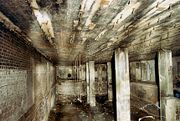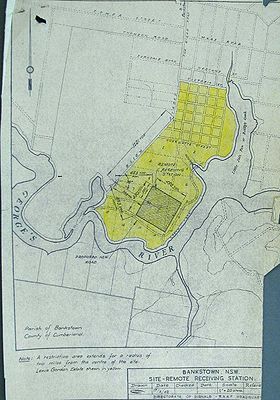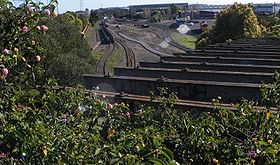
Bankstown Bunker
Encyclopedia

Bankstown, New South Wales
Bankstown is a suburb of south-western Sydney, in the state of New South Wales, Australia. Bankstown is located 20 kilometres south-west of the Sydney central business district and is the administrative centre of the local government area of the City of Bankstown.-History:Prior to European...
.
After the arrival of General Douglas MacArthur in Australia during the Second World War
World War II
World War II, or the Second World War , was a global conflict lasting from 1939 to 1945, involving most of the world's nations—including all of the great powers—eventually forming two opposing military alliances: the Allies and the Axis...
, Bankstown Airport
Bankstown Airport
Bankstown Airport is a general aviation airport and business park located in the City of Bankstown, from the central business district of Sydney, Australia...
was established as a key strategic air force base to support the war effort. During this period the specially constructed bunker became an important Royal Australian Air Force
Royal Australian Air Force
The Royal Australian Air Force is the air force branch of the Australian Defence Force. The RAAF was formed in March 1921. It continues the traditions of the Australian Flying Corps , which was formed on 22 October 1912. The RAAF has taken part in many of the 20th century's major conflicts...
headquarters from 1945 until its closure in 1947.
The Bankstown bunker is currently buried under a public park which lies at the end of Taylor Street.
History


Covert operation
A covert operation is a military, intelligence or law enforcement operation that is carried clandestinely and, often, outside of official channels. Covert operations aim to fulfill their mission objectives without any parties knowing who sponsored or carried out the operation...
Royal Australian Air force base. Construction of the facility commenced in late 1942 at a cost of £
Australian pound
The pound was the currency of Australia from 1910 until 13 February 1966, when it was replaced by the Australian dollar. It was subdivided into 20 shillings, each of 12 pence.- Earlier Australian currencies :...
30,579 with its official commissioning in January 1945 as the headquarters for No. 1 Fighter Sector RAAF
No. 1 Fighter Sector RAAF
No. 1 Fighter Sector was a Royal Australian Air Force unit formed at Bankstown, New South Wales on 25 February 1942.The RAAF commandeered Capitol Theatre at Bankstown for use as an operations and plotting facility on 14 March 1942....
. This unit had previously operated from the Capital Hall picture theatre in Bankstown and a tunnel under the St. James Railway station
St. James railway station, Sydney
St James is an underground railway station on the City Circle line in Sydney, Australia. The station is located under the northern end of Hyde Park, and is named after nearby St James Church...
.
The primary use of the Sydney Air Defence Headquarters was the location, tracking and interception of all planes in the eastern area of the South West Pacific. It was the heart of the Australian defence network, where, in co-operation with the highest officers of Navy and Army, Australian bombers and fighters were controlled in defence and attack against the enemy from this location.
The bunker was manned at all times in shifts that the Air Force called "Flights". Most of the personnel that worked in the bunker were local. Even so, the Air Force provided accommodation for them in Chapel Road, Bankstown whilst buses with blacked out windows transported military personnel to the bunker. All staff for the bunker had to undergo special training, including 'plane identification' training that also took place at Chapel Road.
The bunker was manned by members of the No.2 Volunteer Air Observer Corps
Volunteer Air Observers Corps (Australia)
The Volunteer Air Observers Corps was an Australian air defence organisation of World War II. The VAOC was formed on 31 December 1941 to support the Royal Australian Air Force by sighting and observing aircraft over Australia. The VAOC swiftly established observation posts across Australia and...
, the Women's Auxiliary Australian Air Force
Women's Auxiliary Australian Air Force
The Women's Auxiliary Australian Air Force was formed in March 1941 after considerable lobbying by women keen to serve and by the Chief of the Air Staff who wanted to release male personnel serving in Australia for service overseas. The WAAAF was the first and largest of the World War II...
, members of the Royal Australian Air Force
Royal Australian Air Force
The Royal Australian Air Force is the air force branch of the Australian Defence Force. The RAAF was formed in March 1921. It continues the traditions of the Australian Flying Corps , which was formed on 22 October 1912. The RAAF has taken part in many of the 20th century's major conflicts...
and the United States Army Air Forces
United States Army Air Forces
The United States Army Air Forces was the military aviation arm of the United States of America during and immediately after World War II, and the direct predecessor of the United States Air Force....
.
A transmitting station for the bunker was located in Johnston Road, Bass Hill
Bass Hill, New South Wales
Bass Hill, a suburb of local government area City of Bankstown, is located 23 kilometres south-west of the Sydney central business district, in the state of New South Wales, Australia, and is a part of the South-western Sydney region.-History:...
and was a building of above ground construction.
The bunker appears to have been decommissioned when the ADHQ was disbanded in 1947. A caretaker was then assigned to the take care of the bunker.
It wasn't until 1971 that members of No. 2 Stores Depot RAAF in Regents Park
Regents Park, New South Wales
Alternate uses: Regents Park Regents Park is a western suburb of Sydney, in the state of New South Wales, Australia. Regents Park is located 22 kilometres west of the Sydney central business district, in the local government area of Auburn Council.-History:The suburb took its name from a local...
invited the then editor of Bankstown's Torch Newspaper, Phil Engisch into the bunker. Many photos were taken and an article was placed in local newspapers detailing the find. In 1972, arsonists set the bunker on fire. In 1976 the NSW Department of Housing acquired the land the bunker is built under and redeveloped the area into the townhouses that now cover most of the site. The area now comprises a number of separate complexes or "Closes" containing eight to eleven villas. Each Close is named appropriately after a type of aeroplane that flew from Bankstown during the Second World War.
Inside the bunker
The Bankstown Bunker is of similar design to the underground Ops rooms of wartime England, which directed Britain's air defence fighter plane attacks on the invading German LuftwaffeLuftwaffe
Luftwaffe is a generic German term for an air force. It is also the official name for two of the four historic German air forces, the Wehrmacht air arm founded in 1935 and disbanded in 1946; and the current Bundeswehr air arm founded in 1956....
. Entrance to the bunker was obtained through a concrete passageway which was well screened by a grassy slope, a stairway led to a virtual maze of corridors and hallways leading to various sections.
The walls of the bunker were 1.5 metres thick and it could almost withstand a direct hit from a 300 lb (136.1 kg) bomb. It had all the attenuated fixtures necessary to run a top secret operational defence base. It consisted of three Fixer Stations and one Homing Station
Homing beacon
A homing beacon is a radio or acoustic device that allows the user to track a ship, aircraft, an animal, or another individual. Depending on the beacon, the range can be as short as a hundred metres, or, in science fiction, allow for tracking a ship through hyperspace....
. There were switchboards directing up to fifty telephone lines that went to various locations including radar stations and VAOC lookout posts which reported aircraft locations to the bunker. The bunker was also equipped with its own code room, plotting rooms, two escape tunnels and a radio transmitter room. In the centre of the bunker was a large room of about two-stories in height. This was the main Ops room and control centre for all RAAF Missions in the Pacific area. The room also had a large map, (24' x 18') denoting troop positions in the South West Pacific theater of World War II.
The facilities inside the bunker also had to cater for the full time staff who lived and worked in the facility, working on a rotating roster that involved living in the bunker for two-week periods. The living quarters consisted of its own kitchen, dining area, bathrooms and bedrooms.
The bunker also had its own generator and air conditioning.
There are rumors of a tunnel running from the bunker to an unknown location.
Location
There is a small reserve between the town houses at the end of Taylor Street. It is under this hill that the bunker has been buried. The entrance to the bunker has now been sealed and the area over the top of the bunker has been landscaped to conceal its position, to the point that it is completely undetectable from the street.Other bunkers in the City of Bankstown


Picnic Point, New South Wales
Picnic Point, a suburb of local government area City of Bankstown, is located 23 kilometres south-west of the Sydney central business district, in the state of New South Wales, Australia, and is a part of South-western Sydney region...
National Park, near the South Sydney Power station. According to residents of the area, it still exists. Based on a comparison of contemporary and historic maps, the Receiving Station and the present day Sydney South electricity substation share the same footprint, with the latter apparently situated directly above the former. The substation is bounded on its southwestern and southeastern sides by Henry Lawson Drive, in the Georges River National Park
Georges River National Park
Georges River is a national park in New South Wales , 18 km southwest of Sydney. It is set along the Georges River, and is run by the National Parks and Wildlife Service....
. It is alleged that there are several other bunkers in the Bankstown area, such as under an electricity block house on the corner of Milperra
Milperra, New South Wales
Milperra, a suburb of local government area City of Bankstown, is located 24 kilometres south-west of the Sydney central business district in the state of New South Wales, Australia, and is a part of the South-western Sydney region.-History:...
road and Henry Lawson
Henry Lawson
Henry Lawson was an Australian writer and poet. Along with his contemporary Banjo Paterson, Lawson is among the best-known Australian poets and fiction writers of the colonial period and is often called Australia's "greatest writer"...
Drive, and a demolished bunker under Condell Park High School.
During World War II, Bankstown was a hive for military activity. Bankstown Airport was home to several fighter units and several "dummy houses" existed in and around Bankstown Airport. These houses were built to make Bankstown Airport and its surrounds appear as a farm. Military personnel who worked in Bankstown lived in the area around Chapel Road (where Paul Keating Park and the council chambers are located today). Training facilities for the various plotting rooms around Sydney were also located in the area.
During World War II a major wartime manufacturing plant was located in Chullora
Chullora, New South Wales
Chullora, a suburb of local government areas City of Bankstown and the Municipality of Strathfield, is located 15 kilometres west of the Sydney central business district, in the state of New South Wales, Australia, and forms a part of the Greater Western Sydney region.-History:The suburb of...
. The site once occupied 100 acres (404,686 m²) of land surrounded by Rookwood Cemetery
Rookwood Cemetery
Rookwood Cemetery is the largest multicultural necropolis in the Southern Hemisphere, located in Sydney, New South Wales, Australia...
, Brunker Road, the Hume Highway
Hume Highway
The Hume Highway/Hume Freeway is one of Australia's major inter-city highways, running for 880 km between Sydney and Melbourne. It is part of the Auslink National Network and is a vital link for road freight to transport goods to and from the two cities as well as serving Albury-Wodonga and...
and Centenary Drive. The site was said to have been the largest secret manufacturing plant in Australia which was used for the production of military weapons, plane components, tanks, and ordnance. Over two-thousand men and woman were employed to work at the factory on a daily basis. During the war the factory produced components for 700 Beaufort, 380 Beaufighter and up to 50 Lincoln aircraft. Over 54 ACI tanks were built as well as 60 General Lee tanks that were adapted for use in the Australian Military, as were local jeeps in the 70s. The factory also produced 81 cupola turrets
Gun turret
A gun turret is a weapon mount that protects the crew or mechanism of a projectile-firing weapon and at the same time lets the weapon be aimed and fired in many directions.The turret is also a rotating weapon platform...
for the British
United Kingdom
The United Kingdom of Great Britain and Northern IrelandIn the United Kingdom and Dependencies, other languages have been officially recognised as legitimate autochthonous languages under the European Charter for Regional or Minority Languages...
Matilda tanks.
An underground "bunker" and tunnel system is apparently located on this site. It is directly under a block flats in Davidson Street and Marlene Crescent. The entrance to the "bunker" is by steel doors set in concrete into the hillside in a railway cutting which runs from alongside the railway line parallel to Marlene Crescent at a platform called the Railwelders and which leads under the block of flats. The doors to this "bunker" were welded up in the late 1980s. The ventilation shafts that were once visible from the Hume Highway
Hume Highway
The Hume Highway/Hume Freeway is one of Australia's major inter-city highways, running for 880 km between Sydney and Melbourne. It is part of the Auslink National Network and is a vital link for road freight to transport goods to and from the two cities as well as serving Albury-Wodonga and...
have been removed.
Apart from the bunker, there is also a network of storage facilities that extend under the railway workshop. Sometime between 1977 to 1978 the steel access doors were fitted with locks (Railway SL type). The steel access doors were bolted into the side of a stormwater drain which runs along the old RTA
Roads and Traffic Authority
The Roads and Traffic Authority is a former New South Wales government agency that was responsible for major road infrastructure, licensing of drivers, and registration of motor vehicles. The RTA directly managed State roads and provided funding to local councils for regional and local roads...
building in Chullora, then under the Hume Hwy and eventually under the rail workshop. It has also been alleged that a tunnel approximately four miles long connects this complex with the Bankstown Bunker.
Burke's Backyard
The Bankstown Bunker was on an episode of Burke's BackyardBurke's Backyard
Burke's Backyard is an Australian gardening and lifestyle program, broadcast on both radio and television. On television, it was a regular weekly series on the Nine Network from 1987 to 2004.- History :...
. Don Burke
Don Burke
Donald William "Don" Burke OAM is an Australian television personality and author. He is best known as the long time host of Burke's Backyard, a lifestyle program which ran for 17 years from 1987 to late 2004 on the Nine Network. It has returned several times over recent years with a number of...
conducted part of the show from inside the bunker. To enter the bunker he had to crawl in through an air vent.

